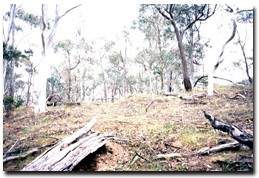Site 8 Porcupine Road Bushland Reserve
Site is in a stable environmental condition
Description
This site is reserved as a Conservation of an Area of Natural Interest, commonly referred to as a Bushland Reserve. In the past it was gazetted as a Gravel and Camp Reserve (Stimson May 1998). The area is at an altitude of 250 m to 260 m with an easterly aspect and the area consists of gentle ridges on Palaeozoic sediments just above an alluvial plain with some Tertiary sediments adjacent.
The area is of moderate habitat value due to low numbers of introduced plant species, range of habitat trees, but small size of the reserve.
Vegetation Description and Composition The EVC represented at the site is Grassy Dry Forest/Heathy Woodland mosaic and contains Eucalyptus melliodora (Yellow Box), Eucalyptus macrorhyncha (Red Stringybark) and Eucalyptus blakelyi (Hill Red Gum) with a diverse herbaceous layer, now over fifty native species present (an increase of about 50% over 1997 survey results). The site has a low proportion of introduced species in the herbaceous layer, comprising mainly pasture weeds. There appears to be minimal change in the vegetation survey results when compared with previous vegetation data. However, the level of abundance has decreased and the amount of leaf litter has increased. Both of these changes can be contributed to the continued dry conditions. The vrot Pimelea williamsonii (Williamson’s Rice–flower) is still present. |  Large amounts of leaf litter are scattered across the site in response to dry seasonal conditions |
Eight trees are monitored for tree canopy health using a 20-point system assessing canopy size and density, number of dead branches and extent of epicormic growth. Leaf damage by insects is also assessed. Trees at this site are reasonably healthy and have remained so since monitoring commenced in 1997. The only observation of note is the canopy density on some trees has diminished due to dry conditions.
Groundwater and salinity
Only one deep bore is located near the reserve and has shown a continuing downward trend in water table levels in response to several dry years. The watertable has dropped from 12.0 m in June 2002 to 12.8 m in March 2003. The salinity reading recorded in 2002 was 4 400 EC, moderately saline.
Birds
Bird species seen at the time of vegetation and tree health surveys include:-
Grey Shrike Thrush, Magpie, Mistletoe Bird, Red-rumped Parrot, Red Wattlebird, Rufous Whistler, Striated Pardalote, Superb Fairy-wren, Tree Martin, White-browed Woodswallow, White-plumed Honeyeater, Willie Wagtail, Restless Flycatcher, Eastern Rosella, White winged Choughs and Cockatoos.
Threats to the site continue to be:
- grazing by rabbits and kangaroos
- weed invasion from adjacent farmland
- dumping of garden rubbish


